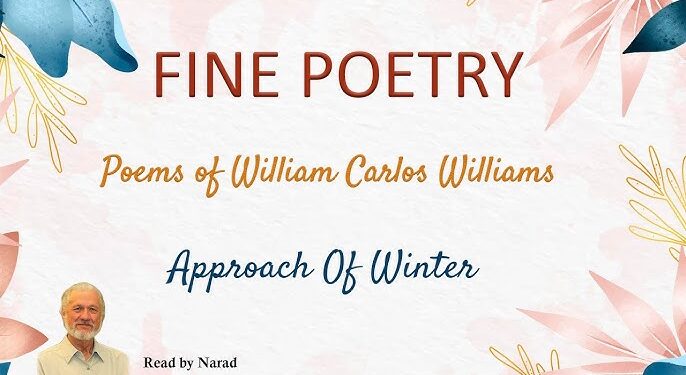Table of Contents
ToggleIntroduction
Approach Of Winter Summary By William Carlos Williams William Carlos Williams was a major figure in American modernist poetry, known for his concise and vivid portrayals of everyday life. His works often emphasize the beauty of the ordinary, with particular attention to the details of the natural world. “Approach of Winter” is a classic example of Williams’ ability to capture the subtle shifts in the environment and human experience.
In this poem, Williams explores the transition from fall to winter, not only in terms of the natural world but also in the emotional and psychological realms. By describing the “approach of winter,” the poet reflects on the inevitability of change and the way seasons mirror the cyclical nature of life. The imagery in the poem invites readers to witness the beauty and harshness of nature as it prepares for winter’s arrival, while also considering the quieter, more introspective emotions that the season brings.
This detailed discussion will offer a comprehensive summary of the poem, analyze its central themes, and provide insight into its symbolic elements. Along with an in-depth exploration, this analysis will address frequently asked questions to further clarify the poem’s meanings and implications.
Summary of “Approach of Winter”
William Carlos Williams’ “Approach of Winter” portrays the subtle yet powerful change in the natural world as the season transitions from autumn to winter. Through simple yet evocative language, the poem captures the shift in both the physical environment and the emotional atmosphere, suggesting that the approach of winter is more than a seasonal change—it is a moment of introspection and transformation.
Read more
Stanza-by-Stanza Breakdown
- Stanza 1
The first stanza sets the scene by describing the natural world’s preparation for winter. Williams highlights the slow, inevitable changes in the environment—the fading warmth of autumn, the gradual disappearance of foliage, and the approaching chill. The tone is somber yet contemplative, suggesting a quiet transition rather than an abrupt shift. The imagery of “dull” and “fading” reinforces the idea of loss and decline, evoking a sense of melancholy. - Stanza 2
In the second stanza, Williams moves away from the external landscape to reflect on human emotions. He describes the “shadow” that comes with winter, metaphorically indicating a sense of gloom or introspection that the cold months often bring. The emotional shift mirrors the physical changes around the speaker, illustrating the deep connection between nature and the human psyche. There is a sense of isolation or retreat, with the chill and quiet of winter calling for personal reflection. - Stanza 3
The third stanza continues this exploration of emotional and psychological states. The “sound” of winter is described—silent but ever-present. The sensory experience of cold, combined with the physical transformation of the landscape, becomes a metaphor for the way the human experience changes during the colder months. The poet’s use of sensory details emphasizes how the world slows down, and how both nature and people respond to the withdrawal that winter brings. - Stanza 4
The final stanza brings the poem to its emotional climax. Williams brings the imagery of winter and human solitude together, suggesting that the cold season is not just a time of natural dormancy but a time for deeper thought and introspection. The “approach” of winter is not merely a shift in weather but a transformative event that invites people to consider their own place in the world. The cold becomes a vehicle for thought, symbolizing both an end and a beginning.

Themes in “Approach of Winter”
1. The Cycle of Nature
The transition from autumn to winter in Williams’ poem highlights the cyclical nature of life and the inevitability of change. Just as winter follows autumn, so too do periods of growth, decline, and renewal. The poem mirrors these natural cycles through its imagery of fading warmth and encroaching cold, suggesting that each season serves its purpose in the broader rhythm of life.Approach Of Winter Summary By William Carlos Williams
Read more
2. Isolation and Reflection
Winter often symbolizes a time of retreat, introspection, and solitude. The poem emphasizes how the external world mirrors the emotional states of individuals during this season. The cold and quiet of winter compel a withdrawal into oneself, making it a time for reflection, self-awareness, and perhaps even melancholy. Williams’ use of silence and fading imagery evokes a mood of solitude, suggesting that winter is not just a time of environmental change but a time for emotional transformation as well.
3. The Beauty of Subtle Changes
Williams was known for his ability to find beauty in the seemingly ordinary or mundane. In “Approach of Winter,” he captures the subtle transformations that occur as autumn transitions into winter. The poem does not dramatize the change but rather captures it in a quiet, understated way, highlighting the beauty in small details like the fading of color or the increasing chill. This focus on the nuances of nature is a signature aspect of Williams’ work, which seeks to elevate everyday experiences to a level of profound significance.Approach Of Winter Summary By William Carlos Williams
4. Mortality and Time
The coming of winter often serves as a metaphor for mortality, the inevitable passage of time, and the finality of life. Just as the natural world must eventually give way to the harshness of winter, so too must human life acknowledge its own limitations and the inevitable march toward death. The poem’s somber tone reflects this theme, suggesting that the approach of winter is a reminder of the impermanence of all things.Approach Of Winter Summary By William Carlos Williams
5. Nature as a Mirror of Human Emotion
Throughout the poem, Williams draws clear parallels between the changing landscape and human emotional states. The coldness of winter, the retreat into isolation, and the quiet of the season all serve as metaphors for personal introspection. The poem suggests that nature not only reflects human feelings but can also serve as a catalyst for deeper emotional experiences, particularly during a time of personal or collective introspection.Approach Of Winter Summary By William Carlos Williams

Conclusion
Approach of Winter by William Carlos Williams captures the subtle and inevitable transformation from autumn to winter, both in the natural world and within the human spirit. Through his use of simple, evocative language, Williams presents winter not just as a physical season, but as a metaphor for introspection, solitude, and the passage of time.Approach Of Winter Summary By William Carlos Williams
The poem highlights the beauty in quiet, understated change and emphasizes the emotional impact of the colder months. With its focus on nature’s rhythms and human emotions, the poem invites readers to reflect on their own experiences of transition and growth.Approach Of Winter Summary By William Carlos Williams
Read more
(FAQ)
1. What does the “approach of winter” symbolize in the poem?
In the poem, the approach of winter symbolizes both a literal seasonal change and a metaphorical shift in human consciousness. Winter is portrayed as a time of withdrawal, reflection, and emotional isolation, mirroring the way the colder months often prompt individuals to turn inward and examine their lives.
2. How does Williams describe the transition from autumn to winter?
Williams describes the transition subtly, focusing on the fading warmth of autumn and the quiet, inevitable arrival of cold. He uses simple but vivid imagery, such as “dull” and “fading,” to evoke a sense of loss and introspection. The transition is not sudden but gradual, reflecting the natural, unhurried pace of seasonal change.
3. What role does silence play in the poem?
Silence is a key motif in the poem. It reflects both the physical quiet of the approaching winter and the emotional quiet that accompanies introspection. The absence of sound in the poem underscores the solitude and stillness that winter often brings, serving as a backdrop for personal reflection and emotional contemplation.
4. How does the poem reflect Williams’ modernist style?
Williams’ modernist style is evident in his use of simple, everyday language, as well as his focus on the ordinary experiences of life. He emphasizes the beauty of the mundane and avoids overly ornate language. The poem’s reflective tone and attention to small, subtle details also align with modernist themes of introspection and the disillusionment of traditional narratives.
5. What emotional atmosphere does the poem evoke?
The poem evokes a melancholy and contemplative atmosphere. The coldness of winter, the fading beauty of autumn, and the quietude of the landscape suggest a time for solitude and self-reflection. The mood is somber, yet there is an underlying sense of acceptance and peace, as if the speaker is resigned to the passage of time and the changes it brings.
6. Does the poem have a hopeful message?
While the poem primarily reflects on the somber aspects of winter, it also suggests that this season of introspection is necessary for growth and renewal. Winter, as a time of quietude and retreat, is not merely about loss but about the potential for self-awareness and transformation. In this sense, there is a subtle, underlying hopefulness in the acceptance of seasonal and emotional cycles.
7. How does Williams use imagery to convey the theme of winter?
Williams uses imagery of fading warmth, the chill of the approaching winter, and the quiet of the landscape to convey the theme of winter. These images evoke not only the physical aspects of the season but also its emotional and psychological effects—such as solitude, retreat, and reflection. The imagery works to create a vivid, sensory experience of winter’s arrival, both in nature and in the human psyche.

















